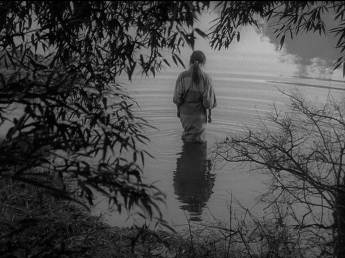This film belongs in the second tier of Hawks’s credits, though it contains in embryo many of the situations and attitudes that would be crucial to his best work. It’s the template of all the Hawks pictures that came after it, as well as most of the derivative ‘buddy’ pictures that owe a debt to Hawks. It doesn’t reach the highest level of Hawks’s achievement because the whole film basically just follows the episodic carousing of randy sailors Victor MacLaglen and Robert Armstrong. Its limited scope only allows for so many variations upon a theme, as opposed to the polyphonic exploration of human dignity found in a film like Rio Bravo or To Have and Have Not.
Louise Brooks emerges in the second half of the film as a carnival performer who must hide her past with Armstrong to secure a future with MacLaglen. (Brooks is introduced, it should be noted, literally gliding across the screen in an amazing low angle shot that simulates the point-of-view of a water bucket. Hawks was still evidently in the fussy, Murnau-influenced stage of his career that he would later denounce.) Brooks’s role is underwritten and her presence, though lovely, is ultimately problematic because it throws into relief the brawny limitations of MacLaglen’s own acting style.
Manpower (1941)
This may be the ultimate MacMahonist movie. Raoul Walsh directs an improbable story of two roughneck linemen buddies (Edward G. Robinson and George Raft) who nearly kill each other over ex-con and clip-joint ‘hostess’ Marlene Dietrich. The filmmaking here is as strong as anything Walsh ever did. The opening five minutes—a crazy montage of big machines, downed power lines, ringing telephones, fast trucks, and loose dancing—features constant camera movement as spectacular as anything in L’Herbier’s L’Argent (1928) and a devotion to speed that would impress any Futurist.
After that things settle down a tad, but the film still derives it effect from unexpected juxtapositions. The most economical and expressive is a memorable image of Dietrich, the night after her honeymoon with Robinson, bending over the kitchen stove in an apron, smoking a slim cigarette. Like everything else in Manpower, this image contributes to a rather discordant fantasy of blue-collar American life. Another image that falls under that index: the grubby linemen playing poker in their well-decorated, white-telephone boarding house. And the subsequent image of a forty-year old kid sliding down the banister of said boarding house with his ass to the camera.
Also notable is the wedding scene in which the traditional bride-and-groom figures atop the cake have been replaced by two towers linked by electrical line. It’s a curiously phallocentric image in this, one of the most homoerotic of studio pictures. If nothing else, it clarifies the implications of the earlier scenes of the linemen bending over an unconscious Robinson and taking turns pumping up and down on his shoulders.
Pas sur la bouche (2003)
A companion piece of sorts to Resnais’s great Mélo (1986), Pas sur la bouche is another unfashionable descent into the popular theatrical forms of the 1920s. Instead of a melodrama, the genre here is the operetta. Resnais preserves (and makes newly legible) the wit of the original piece, but also infuses it with a strange, distanced melancholy. Rather than crafting a reactionary antique, Resnais presents topical satire of the past without any ironic affectation. So, in a small way, he restores the relevance of immigration hysteria of the twenties by unflinchingly, if implicitly, presenting it in the light of recent EU anxieties. More significantly, though, he resurrects an unfashionable style not to evoke nostalgic feelings, per se, but to demonstrate the superficiality of fashion as such: as with Mélo he wrings some enormous emotional depth from a disreputable tradition and, in doing so, confronts his audience with a question about the very meaning of style and form. Caught in the past but pungent in the present, Resnais’s adaptation presents most of the musical numbers in single, gliding takes that play so subtlety with depth, perspective, gesture, and movement that a full appreciation can only be gained after multiple viewings. Again like Mélo (and, for that matter, like Gertrud), much of the feeling and impact of Pas sur la bouche come from the evident and exacting care put into giving each line of text its most sympathetic and supple airing. It’s not a translation of theater so much as a complete consideration of how its materials might best be rendered organic and new for the cinema. About as entertaining as any two hours in the movies and a masterpiece.

2 comments:
Hi, Kyle. I arrived here via the link on the Chicago Reader site. I'm sorry that I couldn't make it to your exhibition's opening reception this afternoon, and I hope it was a success. I will certainly have a good look at the exhibition soon.
All of these posts are very fine, and I am in complete agreement with you on Pas sur la bouche. That film has in fact been my introduction to Resnais, which means, probably, that I started with the dessert.
This is film pretty much has soap opera written all over it. The love triangle between Robinson, Raft and Dietrich has been in every soap from Guiding Light to General Hospital.
Post a Comment